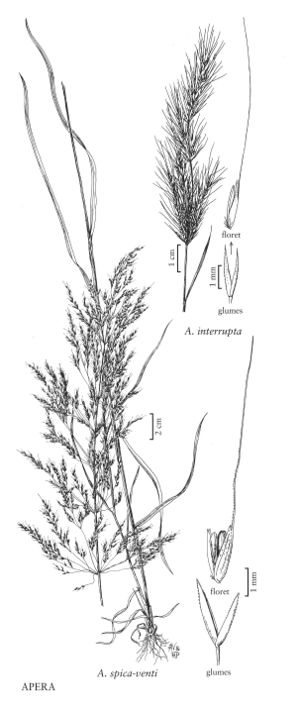| Taxon | Illustrator ⠉ | |
|---|---|---|
 | Apera interrupta Apera spica-venti | Linda Ann Vorobik Hana Pazdírková Linda Ann Vorobik Hana Pazdírková |
Plants annual; tufted or the culms solitary. Culms 5-120 cm, erect or geniculate, glabrous. Leaves mostly cauline; sheaths open, rounded to slightly keeled; collars glabrous, midveins continuous; auricles absent; ligules membranous, often lacerate to erose; blades flat or weakly involute, glabrous. Inflorescences terminal panicles; branches strongly ascending to divergent. Spikelets pedicellate, slightly laterally compressed, with 1 floret, rarely more, distal florets, if present, vestigial; rachillas prolonged beyond the base of the floret as a bristle, rarely terminating in a vestigial floret; disarticulation above the glumes, beneath the floret. Glumes unequal, lanceolate, scabrous on the distal 1/2, unawned; lower glumes 1-veined; upper glumes slightly shorter than to slightly longer than the florets, 3-veined; calluses blunt, glabrous or sparsely hairy; lemmas firmer than the glumes, folded to nearly terete, obscurely 5-veined, marginal veins not excurrent, apices entire, awned, awns subterminal; paleas about 3/4 as long as to equaling the lemmas, hyaline, 2-veined; lodicules 2, free, glabrous, usually toothed; anthers 3; ovaries glabrous. Caryopses shorter than the lemmas, concealed at maturity, 1.2-2 mm, ellipsoidal, slightly sulcate; hila broadly ovate, 1/5 the length of the caryopses. x = 7.
Distribution
Conn., N.J., N.Y., Wash., Del., D.C, Wis., Wyo., N.Mex., Pacific Islands (Hawaii), Ohio, Pa., B.C., Ont., Mass., Maine, Nev., Colo., Md., Calif., Oreg., Vt., Ill., Ind., Ariz., Idaho, Mont., Tex., Utah, Mo., Mich., Ky.
Discussion
Apera is genus of three species, native to Europe and western Asia. It is similar to Agrostis. It differs in its firm lemmas; paleas that are always present and equal to the lemma, or nearly so; and prolonged rachillas. In North America, two species have been introduced, growing as weeds in lawns and disturbed ground, and in grain fields.
Lower Taxa
Key
| 1 | Anthers 0.3-0.5 mm long; panicles contracted, 0.4-3 cm wide; most branches spikelet-bearing to within 2 mm of the base | Apera interrupta |
| 1 | Anthers 1-2 mm long; panicles pyramidal, 2-15 cm wide; branches naked at the base for 5 mm or more | Apera spica-venti |
"decumbent" is not a number.